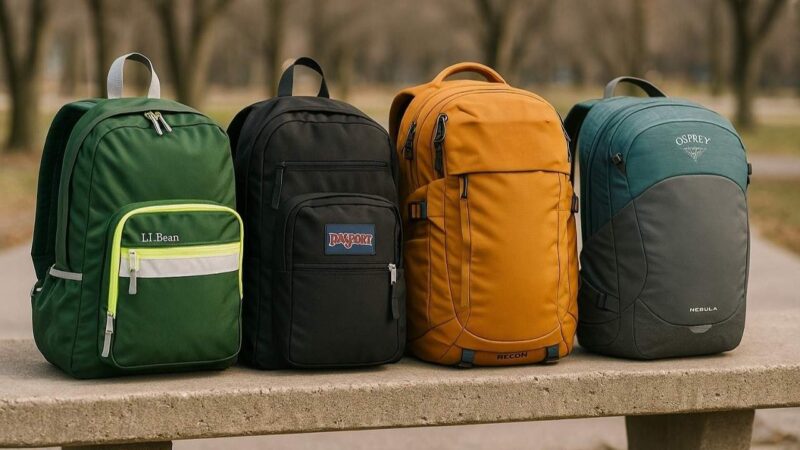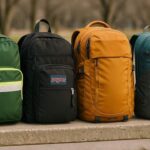Carrying a backpack that feels like a small planet strapped to your back is something most students and commuters know all too well. The textbooks, laptop, water bottle, chargers, maybe a jacket, and then, because life happens, more textbooks.
The strain builds slowly until your shoulders ache and the bag’s seams start whispering their last words.
A solid backpack that can handle heavy books is not a fashion accessory. It’s a piece of equipment, and like any good piece of equipment, it needs to support weight correctly, distribute load, and survive daily abuse without collapsing into a heap of fabric and busted zippers.
With that said, we have prepared a practical guide, built on medical advice, ergonomics, and field-tested products that genuinely perform when you fill them with hardcovers instead of dreams. Let’s get started.
How Heavy Is “Too Heavy” for a Book-Filled Backpack?

Medical organizations have been sounding the alarm about overloaded backpacks for decades. It’s not just a comfort issue, but an orthopedic one.
The American Academy of Pediatrics advises that a backpack should weigh no more than 10 to 15 percent of a child’s body weight. Experts lean toward the lower end of that range, especially for younger kids or those with posture issues.
The National Safety Council points out that many children haul up to a quarter of their body weight in schoolbags. That’s enough to strain backs, necks, and shoulders.
Studies in the U.S. and Europe have shown that average loads often reach 14 to 17 percent, and the heaviest carriers experience far more back pain and fatigue.
For adults, hiking guidelines from outdoor retailers like REI stretch that limit to 20 percent of body weight, but that’s intended for trained hikers, not daily commuters sprinting for the bus with four textbooks and a laptop.
Practical Weight Targets
| Body Weight | Approx. Body Weight (lb) | 10% of Body Weight | 15% of Body Weight |
| 25 kg | 55 lb | 2.5 kg / 5.5 lb | 3.75 kg / 8.3 lb |
| 30 kg | 66 lb | 3 kg / 6.6 lb | 4.5 kg / 9.9 lb |
| 40 kg | 88 lb | 4 kg / 8.8 lb | 6 kg / 13.2 lb |
| 50 kg | 110 lb | 5 kg / 11 lb | 7.5 kg / 16.5 lb |
| 60 kg | 132 lb | 6 kg / 13.2 lb | 9 kg / 19.8 lb |
Physics doesn’t negotiate. No backpack, no matter how well engineered, can cancel out the effect of excessive weight. The best you can do is choose gear that distributes it intelligently.
What Makes a Backpack “Heavy Load Ready”?
Not all bags are built for the grind. Many “school” or “urban” packs chase minimalism and end up being soft sacks with logos.
A heavy-book backpack needs to prioritize structure, support, and durability, qualities that often overlap with tactical backpacks used by law enforcement and field professionals.
1. Wide, Padded, Adjustable Shoulder Straps

Narrow straps are like torture devices disguised as fabric. When you load a bag with thick books, the weight focuses into two small lines that bite into your shoulders.
Proper heavy-load straps should be broad, contoured, and firm enough to hold shape under pressure.
Key features to look for:
- S-shaped straps that follow shoulder anatomy instead of cutting across it.
- Firm, dense padding that doesn’t collapse after a few weeks.
- Smooth adjustment to keep the bag snug against the back.
- Sternum strap, which connects both shoulder straps and keeps them from sliding off. It also stabilizes movement, a detail many brands forget.
2. Hip or Waist Belt
Once the weight climbs, your shoulders shouldn’t suffer alone. A hip belt transfers some load to your pelvis, the part of your skeleton actually built to carry compression.
Outdoor backpacks almost always include them, and now some urban or school packs do too. Even a slim, removable waist belt makes a noticeable difference. Reviewers consistently report that belts cut shoulder fatigue dramatically during long walks.
3. Rigid or Semi-Rigid Back Panel
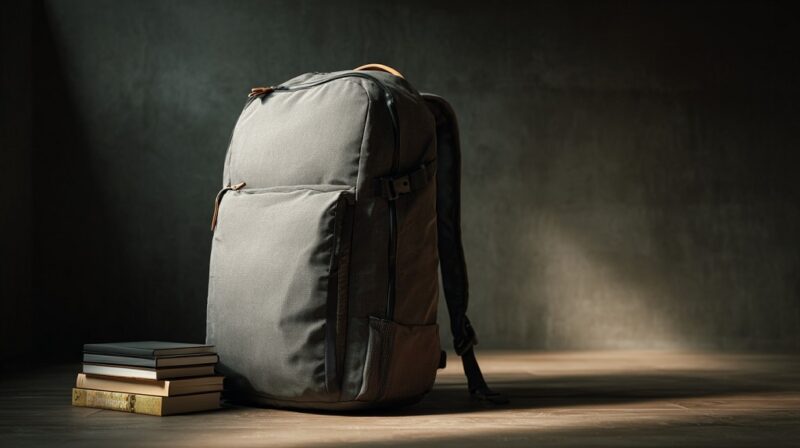
Without structure, your books form a lump at the bottom, pulling backward like an anchor. A rigid back panel or frame sheet prevents that collapse.
The best heavy-load designs:
- Use internal frame sheets or molded panels.
- Keep books and laptops from digging into your spine.
- Maintain an upright shape instead of sagging outward.
Packs like Osprey’s Nebula apply hiking-style internal frames for daily use, keeping the load close to the body. Meanwhile, cheaper fashion bags fold in half once stuffed, which is never a good sign.
4. Compression Straps
Side compression straps aren’t decoration. They cinch the contents close to your back, which stabilizes the center of gravity and keeps books from shifting. Even if your bag isn’t full, tightening compression straps helps it carry more cleanly.
5. Padded, Breathable Back Panel
Firm padding spreads weight over a larger surface area. Mesh backing adds breathability but should not be mistaken for support.
Dense foam panels covered in mesh strike the best balance. Overly ventilated “channel” designs often look advanced but add little actual comfort when carrying real weight.
6. Capacity and Layout That Match the Load
Volume alone doesn’t equal usefulness. A 40-liter fashion pack stuffed with books can feel worse than a 28-liter technical design with smart compartments.
The sweet spot for students and commuters usually falls between 24 and 34 liters:
- One large compartment for textbooks and binders.
- Separate padded laptop sleeve (prevents corners of books from pressing into your device).
- Smaller front pockets for chargers and small gear, to keep them from sinking to the bottom.
Too many small internal pockets can backfire, making it impossible to fit large hardcovers.
7. Durable Materials and Stitching

Heavy loads tear weak bags apart. Look for:
- 600D polyester or high-denier nylon for abrasion resistance.
- Reinforced bottoms (double layers or leather panels).
- Bar-tacked seams where straps meet fabric.
- Reliable zippers like YKK.
Brands that back their gear with long warranties, JanSport, L.L.Bean, The North Face, Osprey, usually do so for a reason. They know the construction will survive years of abuse.
Backpacks That Actually Handle Heavy Books
Below are four reliable, widely tested options known for balancing comfort, durability, and real-world usability.
1. L.L.Bean Original Book Pack

Parents and teachers have been recommending this classic for decades. Reviewers like Wirecutter consistently note that the L.L.Bean Original Book Pack survives years of daily use.
Key Strengths
- Approx. 24 liters of capacity, enough for several textbooks and notebooks.
- Lightweight (around 1 lb), so the empty bag doesn’t add unnecessary weight.
- Durable nylon construction with strong zippers and stitching.
- Reflective accents for safety during early or late walks to school.
- Firm padding on back and straps that prevents books from poking through.
It doesn’t have a sternum or hip belt, but for elementary and middle school students carrying under the 15 percent body-weight limit, it’s well-suited. Parents often report that one pack lasts through multiple school years, which is rare.
2. JanSport Big Student

The name says it all. The JanSport Big Student is built to take oversized loads. With a 34-liter capacity and a two-compartment core, it’s popular among high schoolers and college students who haul everything from laptops to lab manuals.
Load-Friendly Traits
- Padded back panel and ergonomic S-curve shoulder straps.
- Two massive compartments for bulky textbooks.
- Separate 15-inch laptop sleeve.
- 600D polyester fabric and limited lifetime warranty.
Students and parents note that it can easily hold multiple thick textbooks, binders, and gear. Its main limitation is that it lacks a rigid back frame, so when completely stuffed, weight tends to settle lower on the back.
If you walk long distances or have shoulder pain, a more structured option might be better. But for sheer capacity and simplicity, the Big Student remains unbeatable for its price.
3. The North Face Recon
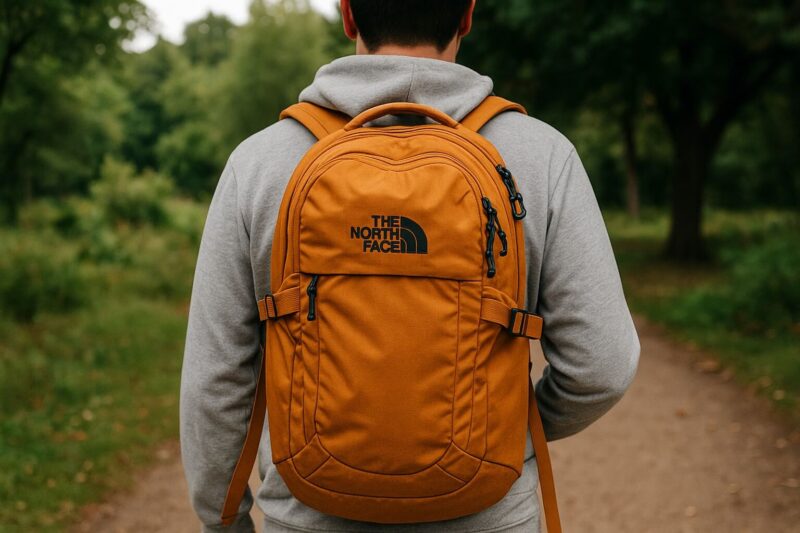
The Recon walks the line between campus style and hiking function. It’s one of the few “urban” packs with genuinely supportive suspension.
Core Features
- Around 30 liters of capacity.
- Thick, structured shoulder straps with sternum strap and optional waist belt.
- Padded, ventilated back panel that keeps its shape even when full.
- Multiple compartments for clear organization.
- Dedicated laptop pocket and tablet sleeve.
Gear reviewers from Pack Hacker to Business Insider repeatedly praise the Recon’s comfort during long wear. Many long-term users report that it handles years of textbook hauling and travel without fraying or deforming. It’s the professional’s answer to overloaded college life.
4. Osprey Nebula 32
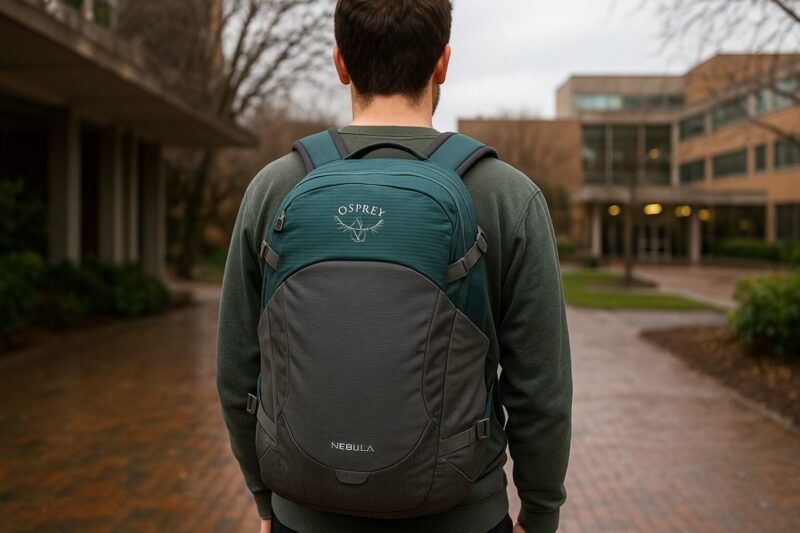
Osprey makes serious hiking gear, and the Nebula 32 borrows much of that DNA. It’s one of the most supportive daily backpacks you can buy without crossing into full hiking territory.
Why It Excels
- 32 liters of storage.
- Internal frame-style back panel that keeps the bag upright and stable.
- Foam harness system with hip and sternum straps that redistribute weight.
- Top and bottom compression straps for load control.
- Laptop and tablet sleeves, both padded and TSA-friendly.
Users often describe the Nebula as feeling lighter than its actual weight because of how it balances the load. It’s not the sleekest look for fashion-oriented settings, but for anyone who walks or bikes with heavy gear daily, it’s one of the most comfortable options available.
Snapshot Comparison
| Model | Approx. Capacity | Structural Support | Load-Friendly Features | Ideal User |
| L.L.Bean Original Book Pack | ~24 L | Soft padded panel | Durable nylon, padded straps, upright shape | Elementary and middle school students |
| JanSport Big Student | ~34 L | Minimal frame, padded back | Two huge compartments, laptop sleeve, warranty | High school or college students with very heavy loads |
| The North Face Recon | ~30 L | Structured back with padding | Sternum strap, waist belt, laptop compartment | High school, college, or commuting adults |
| Osprey Nebula 32 | ~32 L | Internal frame-style panel | Compression straps, hip belt, hiking-grade support | Students and commuters walking long distances |
Fit and Wearing Habits Matter as Much as the Backpack
A high-quality backpack can still cause pain if worn poorly. The rules are simple but easy to ignore.
Use Both Straps
Carrying a full backpack on one shoulder might look casual, but it wrecks alignment. Always wear both straps to distribute weight evenly across your back.
Adjust the Height
The bottom of the backpack should sit at or just above the waistline, not down around the hips. If it sags, tighten the straps. A pack that hangs too low pulls your upper body backward and adds strain.
Pack Heavy Items Close to the Spine
The heaviest items, like textbooks or laptops, should go closest to your back. Lighter gear belongs on the outside. That arrangement reduces the torque on your spine and prevents the bag from dragging backward.
Check the Weight
Doctors often advise parents to weigh a packed backpack at the start of the year. It’s an easy way to see if the load exceeds that 10 to 15 percent target. Many are shocked when they find out how much kids are carrying daily.
Practical adjustments that help:
- Leave unnecessary books in lockers or classrooms.
- Use digital textbooks when available.
- For students with long walks or existing back issues, consider rolling backpacks with wide, stable wheels. They aren’t glamorous, but they’re easier on the spine.
Quick Checklist Before You Buy
Use this list to evaluate any candidate backpack in a store or online listing.
Weight Planning
- Keep daily load under 10–15% of body weight.
- Lighter empty packs make a difference when full.
Fit
- Top should sit no higher than shoulders; bottom above the waist.
- Snug against the back, not hanging or tilting backward.
Straps
- Wide, padded, adjustable.
- Sternum strap for extra stability.
- Hip or waist belt for frequent heavy carriers.
Back Panel
- Firm and padded at minimum.
- Semi-rigid frame for those carrying more than 7–8 kg regularly.
Capacity
- 20–24 L: suitable for younger students or lighter days.
- 24–34 L: ideal for high school, college, or commuters.
- At least one main compartment and a padded laptop pocket.
Durability
- Strong materials (600D polyester, ballistic nylon).
- Reinforced stitching and handles.
- Brand warranty; look for lifetime or multi-year coverage.
Comfort Test
- Load it with real books in-store.
- Adjust straps and walk for a few minutes.
- Check how evenly the weight feels distributed.
Final Words
A backpack built for heavy books is about physics and anatomy. Wide straps, strong seams, and structured panels matter far more than colors or logos. You can make your spine’s life easier by choosing gear that works with your body, not against it.
If you’re still using a floppy fashion bag to carry textbooks, your shoulders probably already know how that story ends. Pick one with real structure, respect the weight limits, and carry smarter. Your back will thank you years from now, even if you never gave it much thought today.

